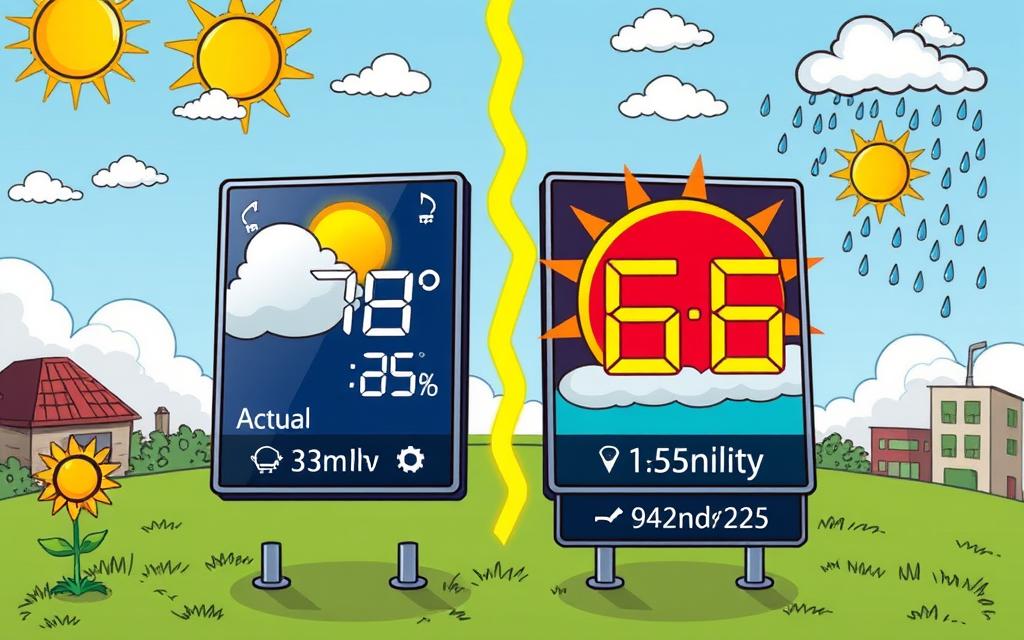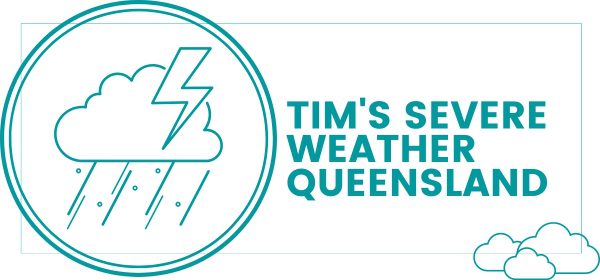Table of Contents
When the mercury soars or plummets, individuals across Australia often refer to the feels-like temperature to describe how searing or bone-chilling the weather actually feels on our skin. This perceived temperature is scientifically known as Apparent Temperature (AT), a measure that takes into account not just the thermometer’s reading but the intricate dance between humidity, wind speed, and other factors that affect human thermal perception. Introduced by Robert G. Steadman in 19841, the concept rings especially true in extreme weather conditions, where the weather discomfort index can significantly differ from actual air temperatures.
In regions like Amarillo, TX, the calculation of the heat index builds upon the existing temperature, incorporating relative humidity to reflect the heightened, often stifling warmth that the body perceives during hot spells, which can be exacerbated by up to an additional 15°F in the presence of direct sunlight2. As the global climate shifts, researchers predict a staggering increase in such indices, potentially reaching levels 10 times higher than what we experience presently by the end of the century3. The stakes are high, as heat-related illnesses and deaths outpace those caused by other extreme weather events, emphasizing the importance of understanding and respecting the might of Apparent Temperature readings and the impact they have on public health3.
While traditional weather reports use the heat index to denote the effects of humidity on warmth, and wind chill to capture the impact of wind during cooler temperatures1, commercial weather services have developed sophisticated models like The Weather Company’s “FeelsLike” and AccuWeather’s “RealFeel” to hone in on the elusive solar radiation factor—a crucial component in the true reading of Apparent Temperature1.
Key Takeaways
- Robert G. Steadman’s concept from 1984 still underpins our understanding of how weather impacts human comfort1.
- The heat index combines air temperature with relative humidity, highlighting how humidity intensifies the perceived heat12.
- Direct sunlight can further inflate the heat index by up to 15°F, affecting both comfort and health2.
- Wind chill quantifies the cooling effect of wind on the body when temperatures dip below 10°C1.
- Innovative efforts by weather companies seek to include solar radiation in Apparent Temperature calculations1.
- Heat-related events hold a significant mortality risk, leading to more deaths annually than severe storms, according to the CDC3.
Understanding Apparent Temperature (AT) and Its Relevance
The concept of apparent temperature (AT) brings a revolutionary perspective to how we interpret weather data, focusing keenly on the human experience of temperature. Its development has reshaped our understanding of thermal comfort and the biometeorological index, thereby improving our capacity to predict and manage environmental impacts on health and well-being.
Origins and Evolution of Apparent Temperature Calculations
The origins of the concept lie in the work of Robert G. Steadman, whose pioneering developments provided a structured method to meld traditional temperature readings with other climatic factors such as humidity and wind speed, to derive a value that more accurately reflects the physiological experience of heat or cold. The inclusion of variables beyond mere temperature data, like relative humidity and wind chill, has modified our approach to describing climatic conditions, often termed as effective temperature.
Apparent Temperature is calculated as AT = Ta + 0.33•ρ − 0.70•ws − 4.00, where ρ = rh • 6.105 • e(17.27*Ta/(237.7+Ta))4.
Applicability of Apparent Temperature in Various Situations
In weather forecasting, the effectiveness of the ‘feels like’ temperature is notable, considering its computation takes into account wind speed, humidity, and the dew point, which affects everyday planning from clothing choices to outdoor activities5. Moreover, specific applications, like the Tempest Home Weather System, provide real-time, precise weather updates, which include indices related to apparent temperature5.
- Health implications are also quantifiable through the heat index in summer or wind chill in winter, impacting decisions related to public safety and work environment structures5.
- Systems like the OSHA-NIOSH Heat Safety Tool App leverage such metrics to offer actionable safety recommendations, emphasizing the need for hydration and appropriate scheduling to mitigate heat-related risks6.
This approach not only aids in personal comfort but also serves a critical function in occupational health, guiding regulations and precautions in workspaces susceptible to temperature extremes6. Such adaptations underscore the relevance and necessity of understanding and applying the apparent temperature in contemporary meteorology and safety protocols.
The Role of Relative Humidity in Apparent Temperature (AT)
The concept of Apparent Temperature (AT) is crucial in understanding how humans perceive thermal conditions, with relative humidity playing a significant role. High levels of humidity can severely limit the evaporation of perspiration, leading to less effective natural body cooling. This, in turn, amplifies the perceived heat, making the actual temperature feel much hotter than it is recorded. This phenomenon is strikingly evident when observing data that at 36.7°C with 55% relative humidity, the temperature might feel closer to an oppressive 47.2°C7.
Conversely, low humidity aids in faster perspiration evaporation, which can help to cool the body more efficiently, resulting in a considerably cooler feeling than the actual temperature might suggest. Thus, perfecting the balance of temperature and humidity levels is a key factor in the accurate reporting of weather forecasts7. This reliance on AT by weather forecasting services helps individuals prepare adequately for the thermal conditions they are likely to encounter, especially during harsh summers known for elevated temperature and humidity levels.

Furthermore, with climate change becoming a pressing concern, extreme heat conditions are becoming more frequent, intense, and prolonged. This exacerbation of climate conditions renders the accurate calculation of AT, considering both temperature and humidity, even more critical. Historically, high humidity conditions have been tied to a significant increment in heat-related health risks, such as heat strokes and dehydration, particularly among vulnerable groups including the elderly, pregnant women, and young children7. These conditions underscore the necessity for heightened awareness and preparatory measures, reinforced through diligently updated weather forecasts.
In light of these concerns, weather forecasting has adapted over the years to include not just traditional metrics like temperature and wind speed, but also more sophisticated indices like the HeatRisk tool. This new development uses a color-coded system to indicate varying degrees of heat risk based on the current weather conditions, effectively incorporating factors like humidity into its risk assessments7.
Ultimately, understanding the role of humidity in the calculation of AT helps the public make informed decisions about their health and well-being during adverse weather conditions, proving crucial for both daily activities and emergency preparedness.
Condition |
Temperature |
Relative Humidity |
Perceived Temperature |
|---|---|---|---|
Typical summer day |
36.7°C |
55% |
47.2°C7 |
Dry & windy |
36.7°C |
30% |
Approx. 34°C7 |
Wind Chill Factor: How Wind Alters Our Temperature Perception
The impact of wind chill is significant when considering the perceived temperature experienced during cold weather. This effect is particularly pronounced as the wind speed increases, stripping away the layer of heated air surrounding the body and exponentially increasing skin cooling8. This accelerated thermal exchange intensifies the sensation of cold, making the external conditions seem harsher than the actual temperature8.
Understanding how wind chill affects perceived temperature is crucial for appropriate dress and activity planning in colder environments. For example, meteorological services use this understanding to provide wind chill warnings, aiding the public in making informed decisions about when and how to prepare for outdoor exposure8.
Further adding to the complexity of perceived temperature, AccuFeel combines multiple atmospheric conditions to deliver a refined ‘Feels Like’ temperature. This system takes into account not only wind speed and air temperature but also factors like humidity, cloud cover, and solar radiation, resulting in a more comprehensive assessment of how the weather impacts human comfort and safety9.
The differences between ‘apparent’ temperature and actual air temperature become critically important as they can influence decisions regarding health risks and outdoor activities. For instance, an actual air temperature of 0°C might feel more like -10°C under windy conditions, prompting necessary precautions like wearing insulated clothing and covering exposed skin to mitigate risks of frostbite and hypothermia8.
By integrating advanced assessments such as AccuFeel and maintaining awareness of weather advisories, individuals can better understand and react to the implications of wind chill on their daily lives and wellness9.
Apparent Temperature (AT) Versus Actual Air Temperature
In understanding weather forecasts and preparing adequately for day-to-day conditions, it is crucial to distinguish between apparent temperature (AT) and actual air temperature. The concept of AT, or perceived temperature, integrates multiple environmental factors beyond mere mercury readings, providing a more comprehensive gauge of outdoor thermal sensation. This measure is invaluable not only for general knowledge but also enhances forecast accuracy, crucial for planning in sectors such as agriculture, sports, and public health.
Discrepancies in Perceived and Measured Temperature
While the actual air temperature might suggest a comfortable day, the perceived temperature could tell a different story. The heat index reveals this discrepancy by combining air temperature with relative humidity. For instance, while the thermometer might read 36.7 degrees Celsius, the feels-like temperature might escalate to a sweltering 47.2 degrees due to elevated humidity levels10. Similarly, wind chill factors reduce the perceived temperature compared to the actual air temperature, often making it feel cooler than the thermometer indicates. An example highlights this phenomenon: a wind speed of 30 km/h can lower the felt air temperature from -5°C to approximately -14°C11.
The Thermal Comfort Equation: Adding Human Perception to Meteorology
Enhancing the accuracy of weather predictions necessitates incorporating a human-centred approach to meteorological models. Including factors like wind speed and humidity refines our estimates, thus aligning predictions closer to actual human experiences of temperature1011. Meteorologists employ models that factor in these dynamic variables to enhance the reliability of weather forecasts, addressing the complex interplay between atmospheric conditions and human comfort. This is subsequently pivotal in advising populations about potential heat-related risks, especially vulnerable groups who might suffer disproportionately during extreme weather conditions10.
Parameter |
Definition |
Impact |
|---|---|---|
Actual Air Temperature |
Temperature measured by a standard thermometer |
Direct measure of air warmth |
Apparent Temperature |
Feels-like temperature considering air temperature, humidity, and wind |
Provides a realistic sense of how the air feels to humans |
Heat Index |
A metric that combines air temperature and relative humidity |
Indicates potential discomfort from high air temperatures exacerbated by humidity |
Wind Chill |
Effect of wind and cold on the perceived temperature |
Describes how cold the air feels, considering wind speed |

Through understanding the vital differences between actual air temperature and perceived temperature, individuals can better prepare for the day ahead, ensuring safety and comfort10. Whether it’s a sunny afternoon or a windy winter day, knowing these details can significantly influence one’s choice of activities and attire.
Thermoregulation and Heat Stress: The Biometeorological Index
In the context of Australia’s unique climate challenges, understanding thermoregulation—the body’s ability to maintain a stable internal temperature—is essential in mitigating heat stress and preventing heat-related illnesses. Apparent Temperature (AT), as a measure, serves as a vital biometeorological index that reflects the potential stress imposed on the human body’s thermal regulation system under various environmental conditions. A scoping review revealed a striking correlation between exposure to high heat stress and adverse maternal and perinatal health outcomes, such as increased risks of preterm birth and stillbirth, highlighting the urgent need for public health advisories particularly tailored towards vulnerable populations12.
Research indicates that not only pregnant women but also newborns, the elderly, and those with chronic medical conditions face heightened vulnerability to the effects of extreme heat and heatwaves. In a startling revelation, it was found that individuals born during more recent times, such as in 2020, are expected to experience significantly more heatwave events compared to those born in 1960, underscoring the escalating challenge posed by global warming. This data calls for proactive strategies in terms of recommending behavioural adjustments and thorough standardization of heat indices to safeguard public health12. Curiously, amongst the extensive studies reviewed, there resides an evident lack of focus on the older and younger demographics aside from the general adult population, indicating a critical research gap13.
The complexity of managing heat stress is further compounded by socioeconomic determinants, which materially influence the health outcomes at the intersection of maternal health and environmental factors. Flaudering hormonal balance, dehydration, and compromised blood circulation during extreme temperature events are just a few of the exacerbating factors identified through scientific scrutiny12. The findings call for heightened interdisciplinary collaboration between climate scientists and health professionals to develop more nuanced, comprehensive guidelines and responses that correlate to the severity of emergent climatic stressors upon public and individual health1213.
FAQ
Q: What is Apparent Temperature (AT) and how is it calculated?
A: Apparent Temperature (AT) is a measure of how hot or cold it really feels to the human body when relative humidity is combined with the air temperature. It’s calculated using a mathematical formula that incorporates air temperature, humidity, and wind speed to produce a perceived temperature for an individual. AT is also known as “feels-like” temperature.
Q: Why is Apparent Temperature (AT) relevant?
A: AT is relevant because it provides a more accurate representation of the thermal conditions that people will actually experience. It takes into account factors that affect human thermal perception, such as humidity and wind, which can make the air feel hotter or colder than the measured temperature alone would indicate. This helps individuals prepare for the weather and manage health risks associated with temperature extremes.
Q: What is the heat index and how does it relate to Apparent Temperature?
A: The heat index is a component of Apparent Temperature that specifically gauges how hot it feels when humidity is factored in with the actual air temperature. It reflects the body’s inability to cool down through perspiration evaporation under high humidity conditions, leading to a higher perceived temperature or a higher AT on hot days.
Q: How does wind chill affect our perception of temperature?
A: Wind chill affects our perception of temperature by increasing the rate at which our body loses heat in cold conditions. The stronger the wind, the faster it removes the layer of warm air surrounding the body, and the colder the weather feels. The wind chill factor is considered in weather forecasting to provide a more accurate idea of how cold it will feel to humans, especially when the air temperature is below 10°C (50°F).
Q: What is the difference between Apparent Temperature and actual air temperature?
A: The difference lies in human perception. Actual air temperature is a straightforward measure of how hot or cold the air is. Apparent Temperature, on the other hand, is a “feels-like” measurement that includes additional factors such as humidity and wind to reflect the temperature experienced by the human body. This perceived temperature can differ significantly from the actual air temperature, particularly in conditions of high humidity or strong winds.
Q: How do proprietary systems like “FeelsLike” and “RealFeel” enhance understanding of Apparent Temperature?
A: Proprietary systems such as “FeelsLike” and “RealFeel” enhance the understanding of Apparent Temperature by attempting to include even more factors in their calculations, such as solar radiation and the effects of precipitation on thermal sensation. These factors can also significantly affect how warm or cold a person feels, and thus provide a more comprehensive and precise “feels-like” temperature.
Q: How does Apparent Temperature assist in managing health risks?
A: Apparent Temperature helps in managing health risks by informing people about the actual thermal stress their bodies are likely to experience. This can guide decisions on outdoor activities, appropriate clothing, and the need for hydration, shielding vulnerable groups from heat-related illnesses or hypothermia. Public health advisories often use AT to warn about extreme heat or cold conditions.
Q: Can Apparent Temperature be used to assess indoor environments?
A: Yes, Apparent Temperature can also be applied to indoor environments, such as measuring the heat exposure in saunas, assessing thermal comfort in workplaces, or determining the necessity for heating or cooling in residential spaces. It helps ensure that indoor climates are kept within comfortable and safe ranges for human occupancy.
Source Links
- Apparent temperature
- What is the heat index?
- What Does the Heat Index Mean For Your Health?
- Australian Apparent Temperature (AT)
- What Does Feel Like Temperature Mean? Why It Matters
- Heat Index at Work: What You Need to Know | SafetyCulture
- Heat index warnings can save lives on dangerously hot days − if people understand what they mean
- Wind chill factor – (Atmospheric Physics) – Vocab, Definition, Explanations | Fiveable
- Feels-Like Temperature: The Science of Temperature Perception
- Heat index warnings can save lives on dangerously hot days − if people understand what they mean
- How is the ‘Real Feel’ or ‘Feels Like’ Temperature Different from the Actual Temperature?
- A scoping review on heat indices used to measure the effects of heat on maternal and perinatal health
- Vulnerable to heat stress: gaps in international standard metric thresholds – International Journal of Biometeorology


